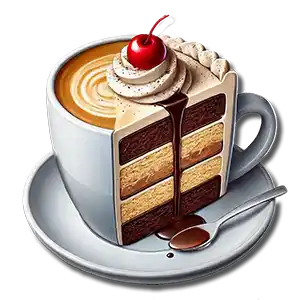A Slice of Sweet History
Good day, fellow caffeine connoisseurs and pastry enthusiasts! Let’s dive into the delicious world of National Coffee Cake Day, a day dedicated to celebrating one of the best companions to our beloved cup of joe: the coffee cake. This day, observed annually on April 7th, is not just an excuse to indulge in sweet, crumbly goodness—it’s a tribute to a tradition that combines the best of baked treats and cozy coffee moments.
The Origins of Coffee Cake
The history of coffee cake is as layered as the pastry itself. While today's coffee cake recipes typically feature cinnamon, fruit, and nut toppings, their origins are a humble mixture of European traditions and American innovation. The concept evolved from a variety of sweet breads made in Europe. Germans had their "kuchen," the Dutch enjoyed "stoet," and the Scandinavians added cardamom and nuts to their versions.
 In fact, the early versions of coffee cake were not much like the sweet, moist cakes we know today. They were more akin to simple yeasted breads, often lightly sweetened and flavored with spices. These early coffee cakes were enjoyed during coffee breaks as a way to slow down and enjoy a moment of indulgence with good company.
In fact, the early versions of coffee cake were not much like the sweet, moist cakes we know today. They were more akin to simple yeasted breads, often lightly sweetened and flavored with spices. These early coffee cakes were enjoyed during coffee breaks as a way to slow down and enjoy a moment of indulgence with good company.
When waves of immigrants from these regions settled in America, they brought their sweet bread recipes with them. However, it was the introduction of baking powder in the 19th century that really gave rise to the coffee cake as we know it today—fluffier and richer than its European predecessors. This innovation transformed coffee cake from a dense, bready treat into the soft, streusel-topped wonder that graces our breakfast tables and afternoon coffee breaks.
Over time, bakers experimented with different ingredients, adding fruit, nuts, and crumbly toppings to enhance texture and flavor. The evolution of coffee cake mirrored the evolution of coffee itself, with new recipes emerging to match the increasingly sophisticated coffee culture in the United States. From the traditional cinnamon swirl to modern variations featuring cream cheese, chocolate chips, and even espresso flavors, coffee cake continues to evolve while maintaining its cherished place in our culinary hearts.
Why Coffee Cake, Anyway?
The moniker "coffee cake" can be a bit misleading, as these scrumptious cakes rarely contain any actual coffee. Instead, the name is derived from the cake's role as a perfect companion to a cup of coffee. This pairing is less about ingredient crossover and more about how well the sweet, often cinnamon-spiced flavors of the cake complement the rich, robust notes of coffee.
Originating from various European traditions where sweet cakes were often served during coffee breaks, the concept blossomed in America. As coffee became a morning staple in households across the United States, the coffee cake emerged as a popular accompaniment, enjoyed for its tasty convenience and social appeal.
In many cultures, especially in Scandinavia and parts of Central Europe, having a slice of cake with coffee is not just a treat but a social ritual; it signifies taking a pause from the hustle of daily life to savor good company and good food. This tradition sailed across the Atlantic, and the American version of coffee cake became a symbol of hospitality—served to guests as a welcoming gesture.
Moreover, the texture and sweetness of coffee cake make it incredibly adept at absorbing the bold flavors of coffee, enhancing the overall tasting experience. Whether it's a buttery streusel topping, a swirl of cinnamon, or a sprinkle of nuts, these elements add a delightful contrast to the smooth bitterness of coffee, making each bite a perfect balance of flavors.
Fun Facts to Brew Over
As you prepare to celebrate National Coffee Cake Day, here are some fun tidbits to share over your next coffee break:
- Innovation in Flavor: Over the years, coffee cake recipes have evolved to include a plethora of flavors and toppings. From blueberry and pumpkin to pecan and streusel, these cakes can accommodate a wide array of taste preferences.
- Presidential Preferences: Did you know that coffee cake was one of President Franklin D. Roosevelt’s favorite desserts? Yes, even the White House couldn’t resist the allure of this sweet treat.
- A Symbol of Hospitality: Serving coffee cake to guests is seen as a sign of good hospitality. It’s a warm welcome that says, "Sit down, relax, and enjoy."
- The Ultimate Excuse for a Coffee Break: The tradition of enjoying coffee cake alongside coffee dates back centuries, reinforcing the idea that snacks and coffee are the perfect pairing.
 How to Celebrate National Coffee Cake Day
How to Celebrate National Coffee Cake Day
What is the best way to celebrate National Coffee Cake Day? Bake, buy, and share coffee cake, of course! Here are some delightful ways to mark the occasion:
- Bake Your Own: Whether you’re a seasoned baker or just starting out, baking your own coffee cake is a rewarding endeavor. Experiment with different fillings and toppings to create your signature recipe.
- Visit a Local Bakery: Support your local bakers by picking up a freshly made coffee cake. It’s a great way to discover new flavors and keep community businesses thriving.
- Coffee Cake and Friends: Invite friends or colleagues over for a coffee cake party. Combine it with a coffee tasting to find the perfect brew to complement your cake.
- Try a New Twist: Instead of the classic cinnamon streusel, try a unique variation—perhaps a coffee-infused cake or a lemon-glazed version.
- Surprise Someone: Deliver a slice (or a whole cake) to a friend, family member, or co-worker to spread the joy of National Coffee Cake Day.
National Coffee Cake Day isn’t just another food holiday. It’s a reminder of the rich cultural tapestry that food weaves into our lives, bringing together history, innovation, and community. So, on April 7th, grab a slice (or two), pour yourself a steaming cup of coffee, and bask in the sweet synergy of coffee and cake. Happy National Coffee Cake Day—may your pastries be fluffy and your coffee cups never empty!
Please Share our Content






 In fact, the early versions of coffee cake were not much like the sweet, moist cakes we know today. They were more akin to simple yeasted breads, often lightly sweetened and flavored with spices. These early coffee cakes were enjoyed during coffee breaks as a way to slow down and enjoy a moment of indulgence with good company.
In fact, the early versions of coffee cake were not much like the sweet, moist cakes we know today. They were more akin to simple yeasted breads, often lightly sweetened and flavored with spices. These early coffee cakes were enjoyed during coffee breaks as a way to slow down and enjoy a moment of indulgence with good company. How to Celebrate National Coffee Cake Day
How to Celebrate National Coffee Cake Day








 "Sláinte!" is a traditional Irish expression used as a toast, equivalent to "Cheers!" in English.
"Sláinte!" is a traditional Irish expression used as a toast, equivalent to "Cheers!" in English.